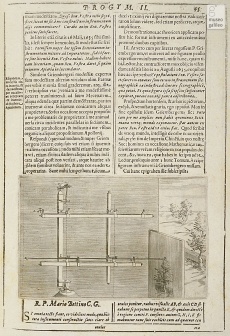Perspectograph by Vincenzo Scamozzi
From Inventions
Has no specific name.
Contents |
Inventor
Vincenzo Scamozzi?
Historic Period
ca. 1580
Description
Instrument illustrated by Senator Giacomo Contarini in relation to a perspective-topographical operation proposed by Giuseppe Moleto. In using this instrument, the points observed through the upper sight are traced on the picture by a stylus sliding inside the lower tube, which is always parallel to the individual visual rays. The resulting visual pyramid is thus artificially doubled, but incorrectly so, because the instrument’s centre of rotation should remain at the centre of the tube (vertex of the visual pyramid intersecting the picture plane) and not at the base of the vertical rod. The origin of this invention is clearly to be found in Daniele Barbaro’s Pratica della perspettiva [The practice of perspective], which describes Baldassarre Lanci’s distantiometer, having a similar sighting device that doubled the visual pyramid. Lanci’s instrument however presented a curved plane, while the one illustrated by Contarini is flat, as in a variant of Lanci’s invention suggested in 1583 by Egnazio Danti in his commentaries to Giacomo Barozzi da Vignola’s Le due regole della prospettiva pratica [The two rules of practical perspective]. An interesting detail in Contarini’s drawing is the view of Roman ruins drawn on the square, which closely resembles the engravings in Vincenzo Scamozzi’s Discorsi sopra le antichità di Roma [Discourse on the antiquities of Rome] (1583), dedicated by Girolamo Porro to the Venetian senator himself. In the dedication Porro praises Scamozzi’s work as architect and scholar “of architecture, and of perspective, his principal professions”, specifying that “In one of these, perspective, he has composed many books ornamented with numerous drawings, which have been seen by Your Excellency with great pleasure and satisfaction.” It thus seems plausible that Scamozzi’s now lost books, known to Contarini, also contained the perspective instruments drawn in this collection; not only the one described here, but also the one illustrated on fol. 17, appearing as a detailed development of Egnazio Danti’s square. Variants of this instrument were also designed by Jean Errard (1584) and Christopher Griemberger (c. 1630). Jean Errard’s instrument, having interchangeable points, could also be used to enlarge or reduce drawings, exactly like the pantograph.
Bibliographical Resources
Contarini, Giacomo. Figure d’istromenti matematici e loro uso , ca. 1590. Oxford, Bodleian Library, Ms. Canon. Ital., 145, c. 40.
Errard de Bar-le-Duc, Jean. Le premier livre des instruments mathematiques mechaniques, Nancy, 1584, tav. 36.
Bettini, Mario. Apiaria universae philosophiae mathematicae: in quibus paradoxa et nova pleraque machinamenta ad usus eximios traducta et facillimis demonstrationibus confirmata: opus non modo philosophis mathematicis, sed et physicis, anatomicis, militaribus viris, machinariae, musicae, poëticae, agrariae, architecturae, mercaturae professoribus etc. utilissimum, curiosissimis inventis refertum figuratum aereis formis cusarum numerosa et speciosà varietate ornatum et in duos tomos distributum, una cum gemino copiosisimo indice, altero propositionum, altero rerum: accessit ad finem secundi tomi Euclides applicatus et condítus ex apiarijs, indicatis usibus eximijs praecipuarum propositionum in prioribus sex libris Euclideorum Elementorum accessere et Analecta. Bononiae, typis Io. Baptistae Ferronij, 1645, Apiarium V, cap. VI (risorsa digitale)
Images
Filippo.jpg
Giacomo Contarini. Figure d’istromenti matematici e loro uso , ca. 1590. Oxford, Bodleian Library, Ms. Canon. Ital., 145, c. 40. |
Mario Bettini. Apiaria, Bologna 1645, Apiarium V, cap. IV, p. 45, variante del prospettografo di Mario Bettini. |
Author of the entry: Filippo Camerota

